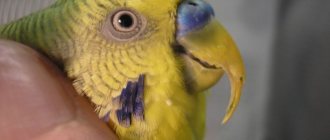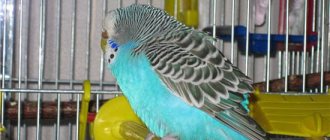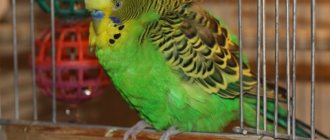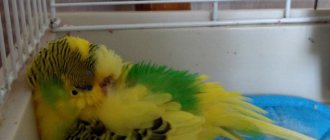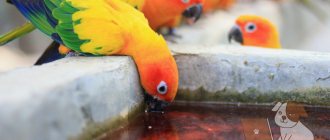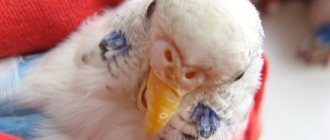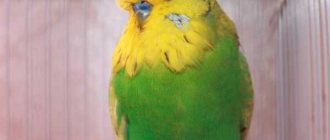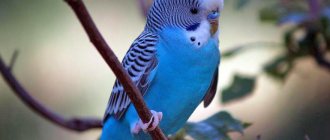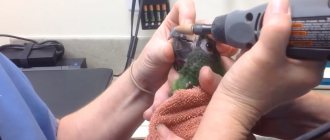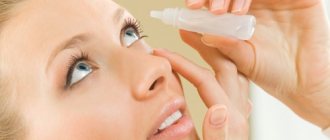- home
- Parrot
- Treatment
02/19/2019 Parrots are very active, friendly and practically problem-free pets. If they are cheerful and healthy, these birds daily give their owners clear trills and the joy of communication. However, if the bird feels unwell, the mood of the bird deteriorates sharply. One of these conditions is called neoplasms on the stratum corneum. When you see a growth or severe hardening on your parrot's cornea, you should immediately consult a doctor, since such a change may be a characteristic sign of a rapidly developing disease.
Cornea of a healthy individual
Based on the condition and appearance of a parrot's cornea, one can not only diagnose dangerous diseases, but also determine the sex and age of the individual.
In a healthy female, the cornea has a paler color, against which white circles at the nostrils stand out. Males are distinguished by their bright colors - blue or purple. The suprabeak area of chicks can have different shades, which gradually change with age. If you thought that you were buying a boy chick, whose cornea subsequently acquired a distinct beige or brownish color, you can safely assume that you have become the proud owner of a girl parrot!
If your pet's cornea is smooth and free of any new growths, there is definitely no reason to worry - this is a bird happy with life!
Beak structure
The beak is a horny formation that replaces both the mouth and nose in birds. The hard shell of keratoid tissue is attached to the nasal bone by ligaments. Consists of two parts: pointed upper and blunt lower. Performs several functions:
- grabbing food;
- feeding chicks;
- nest building;
- protection.
Budgerigars have an anatomical feature: a non-feathered skin growth above the beak, called the cere. This organ serves as the beginning of the respiratory system, as the nostrils are located here. In addition to its main role, the cere facilitates the movement of the beak. Due to the fact that this zone is bare, it can be used to judge the state of the bird's body. Normally, the wax is smooth, warm, and evenly colored.
This is interesting! The color of the cere determines the sex of budgerigars: beige or brown for an adult female, purple or blue for a male. An inexpressive purple hue is a chick less than three months old.
Obvious pathology
The normal state of the beak is considered to be its smooth and even surface of a natural shade, the absence of a growth on the parrot’s nose and other changes in the stratum corneum. Caution must be exercised when the slightest neoplasms appear in the nostril area of the bird. However, unfortunately, most owners notice the problem only when the disease has already progressed.
Experts recommend contacting a veterinarian or ornithologist as soon as possible in cases where a growth near the beak is observed in combination with the following alarming symptoms:
- lethargy and apathy;
- decreased appetite;
- increased excitability and nervousness observed in the behavior of the bird.
Detailed description of possible causes
In terms of frequency of occurrence, the first place is taken by various types of injuries, after which not only the limbs become swollen, but also problems with movement appear.
Injuries
A parrot can get injured both in the cage and outside it. Juveniles often fall from perches and other surfaces. If there is more than one bird in the cage, then the injury may be the result of too active play or a quarrel.
Ordinary bruises can cause the parrot's paw to swell, which will affect its gait (it will limp). In most cases it goes away on its own within a couple of days.
Things are much more complicated with ligament ruptures and fractures that require surgical intervention (in especially severe situations). A difficult fracture can only be determined using an x-ray. In mild cases, you can get by by applying a splint to the injured limb.
Pododermatitis or namins, corns, as they are popularly called
A common problem in adult parrots. The reason may lie in an incorrectly selected cage, perch, nutrition and obesity. It appears as swollen paws, which may also have crusts.
You can notice how the bird draws in its legs and tries not to step on them again, which results in a decrease in activity. The first thing to do is soften the perch with fabric.
Let us also remind you that it is recommended to hang several perches at once in a cage measuring from 12 to 16 mm. Material of manufacture – wood
Also pay attention to the bottom of the cage, which can be softened with foam rubber. In advanced cases, soda-based baths and vitamin therapy may be needed.
If there are crusts and wounds, treatment of the affected areas with chlorhexidine solution 2-3 times a day for 10 days is indicated. As a preventive measure, you can increase the size of the cage, the number of perches and soften all potentially dangerous places. And after the symptoms have reduced, the bird itself is shown active exercises (you can play with it or spend more time than usual), since a sedentary lifestyle is one of the main reasons for the development of pododermatitis.
Gout
An unpleasant pathology that affects almost all individuals over 7 years old. The cause may lie in unfavorable living conditions or infectious processes.
Characteristic features of gout in parrots are swelling of one or two legs at once, the appearance of white nodules on the fingers and feet, which transform into pustules over the course of the process.
You need to understand that gout is incurable, but you can alleviate the bird’s condition by performing a set of measures aimed at treating the affected areas with Chlorhexidine or Dioxidine to eliminate secondary infection. The veterinarian may also prescribe anti-inflammatory drugs (ibuprofen, nurofen) and a vitamin complex, depending on the severity of the symptoms.
Bacterial damage
If there are open wounds on the paws (observed after injuries, gout, ticks), there is a risk of infection and suppuration. A separate place on the leg may swell; upon examination, the presence of pus will be visible.
If pus is discharged, daily rinsing of the wound with a solution of dioxidine, miramistine or chlorhexidine is recommended. After this, levomekol ointment is applied to the affected area. It is recommended to carry out the procedure for 3-7 days until complete healing.
Neoplasms
They can be benign (calluses, papillomas, xanthomas) or malignant (sarcomas, squamous cell carcinoma).
Calluses are often found in adults who spend a lot of time on the perch (if it is made of plastic, then the risk of occurrence increases several times).
Papillomas can be less commonly found in the leg area. According to statistics, their likelihood of malignancy is very low.
Malignant tumors occur in parrots older than 8 years. At the initial stage, the paw may swell, and later a hard lump begins to grow in this place. As the process progresses, blood or pus may be released from it. You will not be able to squeeze it out on your own (you will only bring terrible suffering to the bird). A biopsy and histological examination are necessary to determine the type and stage of the tumor.
If the examination shows satisfactory results for the operation (the ability to endure anesthesia), then the formation is removed within healthy tissue (in 90% of cases the entire leg is removed). There is a high chance of relapse only if the paw is preserved.
Pathogens
Experts indicate that there are several main reasons for the formation of a growth on the beak of a budgerigar. Most often, this deformity is caused by infection, however, it can also be caused by injury.
Let's consider the main types of pathogens that cause corneal tumors.
Scabies mite
The scabies mite is a microorganism that infects the body of a bird with a weakened immune system and causes infection with knemidocoptic mange. As a rule, the infection enters the body of a healthy individual through contact with a sick parrot. Less common are situations where the disease is provoked by contact with dirty soil, grass, or tree bark.
In the early stages, the disease is almost asymptomatic, however, very soon external signs of the disease appear: growths on the cornea covered with a pale film are found, scabies begins, increased molting, and the bird experiences pain in the joints. If decisive action in the form of drug treatment is not taken at this stage of the disease, the consequences may become irreversible.
The standard treatment regimen involves treating the horny growth with special external anti-mite agents, which are designed not only to relieve the itching, but also to rid the bird of the parasite. After completing the medication, it is necessary to disinfect the cage - usually the bird house is treated with a solution of potassium permanganate or any alcohol-containing liquid. It is important to destroy any wooden surfaces that the sick bird has come into contact with.
Owners of birds need not be afraid of becoming infected: the scabies mite is transmitted only to birds and does not affect people.
Avitaminosis
Another common cause of thickening of the stratum corneum near the beak may be banal vitamin deficiency. A lack of vitamin A leads to metabolic failure, and subsequently to the formation of a growth on the wax. Such changes indicate poor nutrition of the bird and the need to review the diet.
To prevent vitamin deficiency and develop a healthy beak in your pet, include fiber-rich foods in its daily menu: cereals, seeds, grains. It is also important to treat your pet to vegetables or fruits every day. The maximum proportion of vitamin A is found in greens and fruit plants: apricots, carrots, turnips.
Injuries
The appearance of a growth on the cornea can cause infection in the wound caused by injury. A parrot can easily damage its beak by hitting an obstacle while flying around the house, getting caught on the steel bars of the cage, or miscalculating the force when contacting sharp objects. Try to make your pet's environment as safe as possible to avoid unpleasant incidents.
Hormonal imbalance
With improper nutrition, not only the metabolism is disrupted, but the hormonal levels of the bird are also disrupted, which also ends in the formation of growths. Often, food purchased at a pet store may contain potentially dangerous additives. In order not to expose your bird to additional risks, do not forget to add fresh vegetables and fruits to dry food.
Viruses
Parrots, like people, are exposed to many viruses, including the widespread herpes. By affecting the immune system, herpes accelerates the thickening of the cornea and causes growths on the paws of budgerigars. At the first signs of herpes, you should contact a qualified specialist as quickly as possible and prescribe the correct treatment.
Period of treatment and recovery of the pet
An illness, even the mildest one, is always stressful, and therefore the little pet needs to be provided with peace and support its body with additional vitamins. The growths take quite a long time to eliminate, so the breeder will have to be patient, not break the course of medication, and be sure to separate the sick pet from the healthy ones.
How to CURE A PARROT for a TICK//SCABIES MITE TREATMENT//CURE FOR A TICK//green parrot TV
Isolation is not so important only when attacked by a scabies mite, since infection occurs too quickly. Under no circumstances should you remove tumors yourself. It is unacceptable to file down growths or cut them off. This can injure your pet even more.
Corneal necrosis
Corneal necrosis is distinguished from other similar troubles by tissue suppuration, accompanied by rapid destruction of the beak. When the disease is not stopped in time, it can be fatal.
The basis of the clinical picture of the disease is the deterioration of blood supply caused by an infection - for example, after rhinitis. An accompanying symptom is itching.
In such cases, only a specialist can remove the tumors by performing an operation under anesthesia. For complete recovery, the birds are prescribed a course of antibiotics after all the procedures performed.
Reasons for appearance
Most often, the appearance of growths on the body of these birds provokes:
- poor nutrition, unbalanced in terms of vitamin and mineral components in the poultry diet;
- inept keeping of parrots in a poorly equipped and undisinfected cage;
- hormonal disorders in the bird's body;
- the presence of parasites on the parrot’s body;
- harmful activity of bacteria and viruses;
- contact with sick birds or animals;
- hyperkeratosis, manifested in excessive growth of the cere;
- papillomas.
Did you know? There are 330 species of parrots alone in the world. The most popular of them living among people are
—
budgies and cockatiels.
Useful recommendations for wavy owners
If you listen to the advice of veterinarians, then any problems with the health of your pet and its beak in particular can be avoided.
It is enough to adhere to the following recommendations:
Periodically examine the parrot for pathologies.- Minimize the likelihood of injury.
- Regularly clean and disinfect the cage with accessories.
- The food should be balanced, and not just dry.
- Fill the cage with branches and stones.
- Do not increase your pet's stress level.
When releasing a parrot from its cage, you should close all the windows and cover the windows with light curtains, otherwise the bird will hit the glass. All sharp objects, as well as equipment, must be covered with a blanket or taken out of the room.
The budgie tastes everything, so any dangerous or valuable things should be removed: if it doesn’t injure itself, it will definitely ruin something.
General cleaning of the cage should be done at least once a week. Moreover, not only clean the tray from excrement and other dirt, but also do not forget to treat all available accessories: drinking bowl, feeder, bathing bowl, perches and toys.
To exclude hypovitaminosis, the bird should be given vitamin complexes, which is especially important during the molting period.
The diet must include fruits and vegetables:
- bananas;
- pears;
- raspberries;
- peaches;
- carrot;
- beet.
It is better to collect branches to fill the cage away from roads, construction sites and landfills. If there are no plantings nearby, then the material can be bought at a pet store. It would be a good idea to put a mineral stone and sepia in the cage. This will not only make up for the lack of calcium, but will also allow the pet to grind down its beak.
Also, do not forget about such an important accessory as a perch . The bird uses the crossbars not only as a perch, but also for sharpening its claws and beak. Cheap store-bought solutions are not suitable here. They are completely smooth and the parrot has nothing to grab onto.
It is better to give preference to wooden products of irregular shape or, as a last resort, trim them manually with a knife. You can also find more expensive concrete perches on sale. This is the best option for beak care.
You cannot equip the cage with soft toys. The parrot will chew them up and clog up its beak and goiter. Accessories must be made of rigid and non-toxic material.
Peppermint treat
Ingredients:
- 1 medium overripe banana.
- 2 chicken eggs.
- 3 tbsp. spoons of honey.
- 3 tbsp. tablespoons of liquid coconut oil (can be replaced with sunflower oil in the same amount).
- 1/2 teaspoon mint flavoring.
- 1/2 teaspoon baking powder.
- A quarter cup of carob (roasted carob powder). A small amount of cocoa can be substituted, but this is not recommended for animals. Therefore, try to find an original product.
- Oat flour.
Cooking procedure.
1. Mash the banana in a bowl.
2. Beat eggs into the resulting mass, add honey, baking powder, cinnamon and coconut (sunflower) oil.
3. Add oatmeal to the mixture to form a firm but slightly moist dough.
4. Divide the resulting volume into 2 equal parts.
5. Pour 1/4 cup of carob powder into one half, and add the same amount of flour to the second half. A hard lump should form that does not stick to your hands.
6. Roll out 2 rectangles, 9-10 mm thick.
7. Place the layers of dough on top of each other and roll along the long side. Wrap the resulting sausage in plastic wrap and put it in the refrigerator overnight.
8. Preheat the oven to 180 degrees.
9. Cover a baking sheet with parchment paper.
10. Remove the film and cut into 3-3.5 cm rounds.
11. Place on a baking sheet. During cooking, portions of dough will not increase in volume, so you can place them close to each other.
12. Bake for 10-15 minutes.
If you want to please your pet with a crunchier treat, cut the rolls into thin slices (about 1 cm), and after cooking, additionally dry them in a warm oven or even in a non-stick frying pan.
The finished product is stored for a long time in a dry place. So, by baking peppermint rolls once, you can treat your four-legged pupil with them for a long time.
Bon appetit to your dog!
I like it I don't like it
Osteosarcoma in a budgie
Vladimir good evening! We have already written to you once about the problem of our parrot. You remotely diagnosed him with osteosarcoma. We never got to you. The tumor continues to grow and has taken over 2/3 of the wing area. They didn’t come up for fear that he wouldn’t survive the operation. He is stronger, he has no shortness of breath, his appetite is good and cheerful. Tell me how the wavy surgery is tolerated, and when is the best time to do it, because it’s summer. Should I bring him in for a consultation?
Gas anesthesia
Good afternoon We perform operations to remove tumors in budgies under gas anesthesia, which makes anesthesia as easy as possible for the budgie. There is really nothing to wait for, since the growth of the tumor does not allow time to be wasted, and it must be removed, otherwise the parrot will definitely die soon. When the tumor is removed, such an event may not occur.
Sincerely, Vladimir Romanov
Homeland of budgerigars
An intelligent and energetic bird native to Australia. It is in the eucalyptus forests of the southeastern and southwestern parts of the continent that entire flocks of sociable parrots live. Despite the huge number of fellow tribesmen, there is a clear hierarchy in the bird community.
Many pet lovers have birds that live at home and feel great. Budgerigars are full-fledged members of families along with dogs and cats. The cheerful chirping of pets pleases their owners, and the ability to reproduce human speech can save the owner from feelings of loneliness. However, how long the life of a cheerful parrot will be will depend on the conditions of its keeping.
For greater convenience, the bottom of the cage should extend and not contain bars. It is not recommended for birds to place litter in their homes. It is best to place a sand bath where the parrot will enjoy bathing.
Homeland of budgerigars
An intelligent and energetic bird native to Australia. It is in the eucalyptus forests of the southeastern and southwestern parts of the continent that entire flocks of sociable parrots live. Despite the huge number of fellow tribesmen, there is a clear hierarchy in the bird community.
Many pet lovers have birds that live at home and feel great. Budgerigars are full-fledged members of families along with dogs and cats. The cheerful chirping of pets pleases their owners, and the ability to reproduce human speech can save the owner from feelings of loneliness. However, how long the life of a cheerful parrot will be will depend on the conditions of its keeping.
For greater convenience, the bottom of the cage should extend and not contain bars. It is not recommended for birds to place litter in their homes. It is best to place a sand bath where the parrot will enjoy bathing.
Possible complications
The cause of stressful conditions must be eliminated, and if there is an underlying disease, appropriate treatment is selected, otherwise skin inflammation will progress, causing suffering to the pet.
Call a veterinarian to your home 24 hours a day
Our veterinary center offers the services of experienced ornithologists who will make the correct diagnosis and help your pets return to their normal lives.
To do this, they have modern diagnostic methods and their own laboratory at their disposal.
Doctors are ready to go to patients’ homes in Moscow and the Moscow region.
By calling a doctor at home, you get the following benefits:
- save your time, which you can spend on other goals,
- take care of your pet, who remains in a comfortable environment for him,
- Receive valuable recommendations for improving your pet’s living conditions.
The price list is the same for all patients, regardless of the place of examination. Since we work around the clock, you can invite a doctor at any time of the day.
Call the numbers listed on the website and coordinate the day with our administrator.
General services
| Prices for services in our clinic | In the clinic and at home |
| Ornithologist visiting your home | from 500 |
| Clinical examination, preliminary diagnosis, consultation | from 500 |
| Telephone consultation | for free |
| Therapy | from 150 |
| Surgery | from 150 |
| Ambulance at home (within an hour) | from 1000 |
Therapy
| Prices for services in our clinic | In the clinic and at home |
| Subcutaneous administration of medication to birds | from 200 |
| Intramuscular administration of medication to birds | from 150 |
| Intravenous administration of the drug to birds | from 500 |
| Bird dropper | from 1000 |
| Administration of the drug intraperitoneally, intraosseously | from 800 |
| Nerve receptor blockade in birds | from 500 |
| Tube feeding of birds | from 300 |
| Cleaning the horny cover | from 400 |
| Resuscitation treatment of birds | from 1500 |
| Infusion therapy | from 250 |
| Intravenous catheter placement | 500 |
| Removing the IV catheter | 500 |
| Removing the Marking Ring | from 200-1000 |
| Taking blood for laboratory tests | from 350 |
| Obstetrics in birds | 1 hour from 500 |
| Washing the crop | from 500 |
| Trimming: | |
| Beak | 500 |
| Claws | 500 |
| Krylyev | 500-1000 |
| Tail | 500-1000 |
Surgery and Traumatology
| Prices for services in our clinic | In the clinic and at home |
| Surgical treatment of wounds | from 200-1000 |
| Stitching | from 300-1500 |
| Application of a splint | from 300 |
| Opening abscesses, hematomas | from 300 |
| Removal of tumors | from 1000 |
| Goiter surgery | from 1500 |
| Cloaca surgery | from 1500 |
| Removal of foreign bodies | from 1500 |
| Eye amputation | from 2000 |
| Pelvic limb amputation | from 2500 |
| Osteosynthesis | from 10000-30000 |
| Surgery for goiter rupture | from 1500 |
| Egg extraction | from 500 |
| Anesthesia for birds | from 1500-3500 |
| Puncture of air sacs | from 1000 |
| Abdominal wall puncture | from 1000 |
Ophthalmology
| Prices for services in our clinic | In the clinic and at home |
| Eyelid surgery for inversion, eversion | from 2000 |
| Exenteration of the eyeball | from 3000 |
Laboratory research
| Prices for services in our clinic | In the clinic and at home |
| Taking tests | 500 |
| Clinical blood test | 1000 |
| General clinical blood test | 1000 |
| Blood chemistry | 2000 |
| Microscopy of blood parasites | 700 |
| Smear microscopy | 700 |
| Examination of droppings for protozoa | 1000 |
| Examination of droppings for helminths | 700 |
| Determination of gender | 2000 |
| Histological examination | 2500 |
| Examination of droppings for helminths | 700 |
| Infectious anemia of chickens | 1500 |
| Test for infectious encephalomyelitis | 1500 |
| Analysis for infectious bronchitis of birds | 1500 |
| Analysis for infectious rhinotracheitis in birds | 1500 |
| Salmonellosis test | 1500 |
| Testing for trichomoniasis | 1500 |
| Tuberculosis test | 1500 |
| Examination of droppings for protozoa | 1000 |
| Analysis for psittacosis | 1500 |
| Analysis for pasteurellosis | 1500 |
| Avian influenza test | 1500 |
| Analysis for dysbacteriosis | 2000 |
| Analysis for avian mycoplasmosis | 1500 |
| Newcastle disease test | 1500 |
| Analysis for avian leukemia | 1500 |
| Test for Marek's disease | 1500 |
| Analysis for avian adenovirus | 1500 |
| Analysis for avian circovirus | 2000 |
| Analysis for yeast-like fungi | 1700 |
| Comprehensive analysis for anthropozoonoses | 4000 |
| General bacteriological analysis | 3000 |
| Gumboro disease | 1500 |
| Avian reovirus | 1500 |
